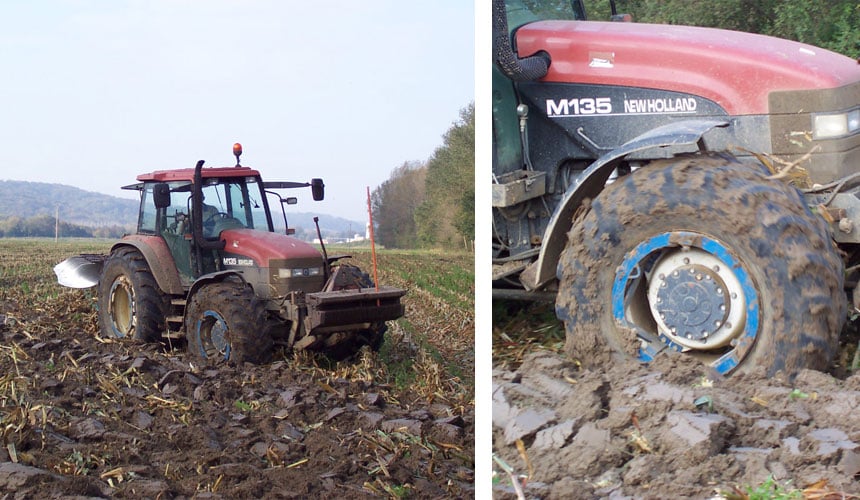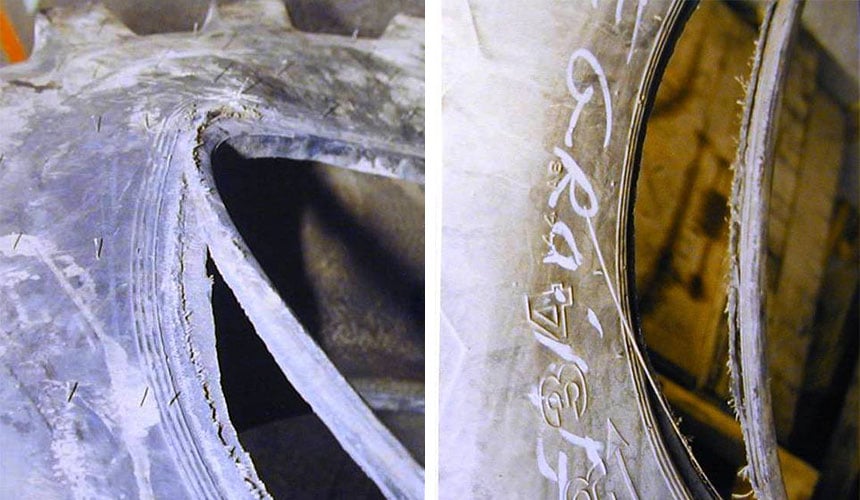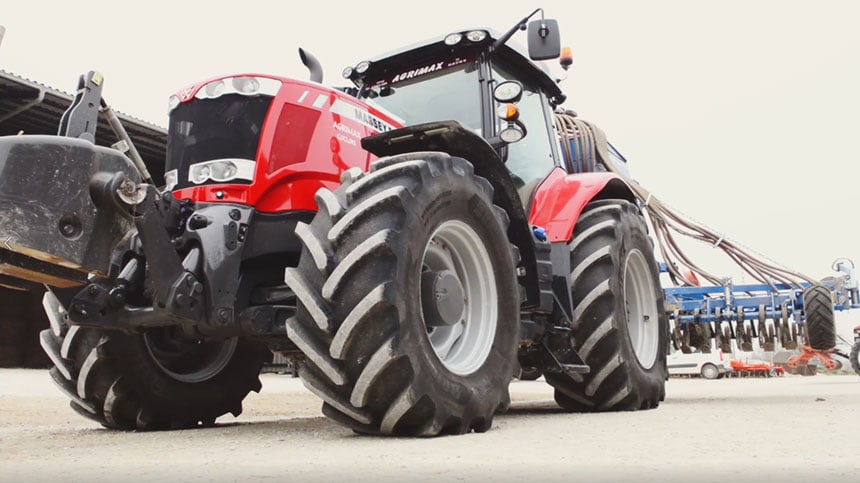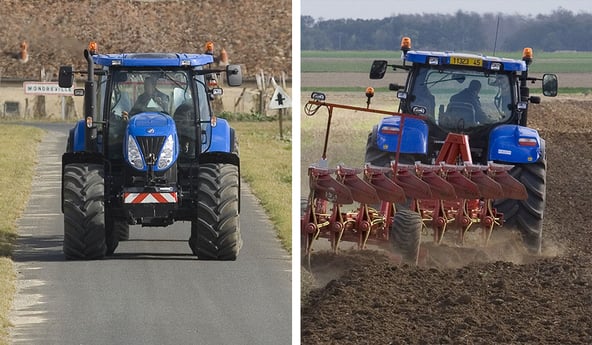Wear is certainly one of the main problems faced by your agricultural tyres, because obviously if this wear is rapid, you will be forced to buy new tyres, leading to increasingly high costs.
Daily pressure adjustments, pressure checks based on load or adapting pressure to take account of the surface on which you travel may appear to be very secondary tasks, which are often considered optional and less important. Unfortunately, they are closely linked and over or under inflation is often the primary cause of accelerated wear to your tyres.
In this article we look at why adjusting inflation pressure is important in limiting wear and in which cases you can manage without adjustments without the risk of endangering your tyres’ lifespan.
Agricultural vehicle tyres are very different from car tyres, they must carry much more load and are placed under considerable strain.
They must be efficient both on the road and in the fields, but with very different types of ground, very hard for asphalt roads and often extremely soft in the fields, if the weather conditions are not good.
It is these major differences: load, type of work and soil which require a different way of managing, preparing and checking agricultural tyres to extend their lifespan.
1. What is the link between wear and overinflated tyres?
To resist load, you must increase inflation pressure to prevent the weight of your implements, or the load transfer when you raise your implements, from crushing your tyres and damaging their structure.
Increasing inflation pressure to compensate for load is recommended for use on the road at high speed and for transport at harvest time, for example.
The problem with highly inflated tyres arises during use in the fields, when the high pressure will be counterproductive. It will generate negative effects which, among other things, will increase wear:
Wear linked to an increase in rolling resistance
If the weather conditions are poor and you have to work in a muddy field, overinflated tyres will tend to sink into the soft ground before meeting resistance.
Your tyres, as well as the soil, are deformable elements, the tyres crush into themselves and the soil compacts in reaction.
The higher the pressure in the tyres, the greater the pressure exerted on the ground, with overinflated tyres sinking into the ground. The quantity of earth in front of the tyre increases mechanically and the effort required to move forward becomes greater. Each extra centimetre of depth corresponds to a proportional increase in friction when moving forward, thus increasing wear.
Wear linked to slipping and sliding
An overinflated tyre does not flatten out much and its contact patch with the ground is limited, which means that the lugs do not a get sufficient hold on the soil , there is very little flexion and the self-cleaning capacity is therefore reduced. All of these phenomena together lead to a considerable increase in slippage.
Slippage is linked to the weather conditions, of course, but also to the level of pressure in the tyres. The distance covered by the tyre with a high slip ratio is greater than the distance actually covered by the tractor.
The loss of power linked to tyre slip on the ground can reach up to 20% or more. This excessive slip over several hectares leads to an acceleration of tyre wear.
 Slip linked to overinflated tyres in wet conditions
Slip linked to overinflated tyres in wet conditions
2. What is the link between wear and under inflated tyres?
In the fields, it is highly recommended to decrease inflation pressure as much as is possible for your tyre model. This will increase the size of the soil footprint, decrease soil compaction, increase traction and reduce slip. However, it’s when you take the road between your fields or to reach a field that its far away that the lack of inflation pressure becomes a problem.
Indeed, on the road, you will increase speed and underinflated tyres are likely to wear much more rapidly.
Heating and tyre wear on the road
An underinflated tyre has a large soil footprint, the contact patch between the rubber and the hard, abrasive asphalt is bigger. When you take the road, you increase speed which mechanically increases the temperature of the tyre. This rise in temperature makes the rubber more supple. All these factors can lead to a rapid increase in wear, all the more so if you travel long distances on the road.
Risk of wear linked to load transfer
Load has a major impact on the tyre, because it’s the tyre which compensates for the implement’s thousands of extra kilos by deforming to some extent. When your tyres are under inflated for work in the fields, because the implement is on the ground, this is a good way of avoiding excessive compaction. However, when it’s time to leave the field, the load transfer from the raised implement to the rear axle is at its maximum, adding thousands of extra kilos to your tyres.
If you work at a low inflation pressure and you don’t adjust this pressure before taking the road, your rear tyres will be placed under considerable strain due to the load, the excessive flexing of the tyres combined with the rise in temperature linked to the speed. In this case the tyres will wear extremely rapidly and the risk of problems or irreversible damage at the level of the casing is quite likely.
 Damage at the level of the bead linked to frequent driving with underinflated tyres
Damage at the level of the bead linked to frequent driving with underinflated tyres
3. Does permanent average pressure cause wear?
Even if agricultural tyres are generally designed to be more solid than car tyres, they cannot be used in the same way. You cannot consider that an average pressure adjustment, carried out a few times a year, will be sufficient for all the very different types of use for your agricultural activities.
Average pressure may well be the worst solution, because in the previous examples, the over inflated tyre was optimal on the road and the underinflated tyre particularly efficient in the fields.
If you opt for average pressure without really checking based on load or type of soil, you will find yourself with an inflation pressure that is systematically wrong, neither optimal on the road nor optimal in the fields.
This choice, which may appear to be the simplest and without consequences, this being the way you manage pressure with your car, is totally unsuitable. Your tyres will wear on the road with too much rolling resistance and they will wear in the fields with too much slip.
This simple and easy choice is probably the best way to reduce the lifespan of your tyres by around 20 to 25%.
4. What are the ways to avoid pressure adjustments?
Regular tyre pressure adjustments based on load, speed and the type of ground are the best way to extend your tyres’ lifespan by thousands of hours. However, it is true that these adjustment operations are a nuisance and add more time to working days that are already very full.
There is a way of avoiding tyre pressure adjustments by using a more technically advanced tyre design.
VF tyres have been specially studied and developed to take into account all these difficulties, without facing the inevitable wear incurred by a tyre produced using standard technology.
 Bridgestone VT-TRACTOR low-pressure VF tyres
Bridgestone VT-TRACTOR low-pressure VF tyres
Bridgestone’s research and development teams have worked on each of the points described in this article to boost the tyre’s capacity, to increase its resistance to wear and to extend its lifespan:
- The rubber design uses a new blend of vegetable oils which improve resistance to wear and give the tyre a much longer lifespan than normal technology tyres.
- A VF tyre such as the VT TRACTOR can carry 40% more load than a standard tyre; its internal structure, the fibres added to the rubber and the number of plies used in the tread have been reinforced.
- A VF tyre can work in the fields at very low inflation pressure: 0.8 bar, because its sidewalls have been designed to be extremely supple and resist flexion without affecting the tyre in the long-term.
- A VF tyre therefore allows you to save time by not having to change inflation pressure between the road and the fields, because its design protects it against wear, even if your inflation pressure is not ideal for the type of ground on which you are driving.
To learn more about ways to increase your farm’s productivity, bridgestone-agriculture has created a comprehensive eBook on the topic which is available for you to download for free:
Bridgestone-agriculture Blog is written and administered by tractor tyre experts who are available to provide you with advice on agricultural tyres. They will help you to maximise your productivity with information on all things relating to tyres: inexpensive tractor tyres, technical data for agricultural tyres, solutions for avoiding soil compaction, sprayer tyre pressure, why and how to ballast your tractor tyres, when to use dual-wheels, the mechanical causes for abnormal wear, discounted agricultural tyres, etc.
Most people who read this article have also read some of the following articles:
- 10 tips to reduce abnormal wear to your farming tyres
- The worst consequences linked to used tractor tyres on your soils
- Why do my front tractor tyres wear much quicker?
- How to limit agricultural tyre wear faced with heavy loads
- When does a split make it necessary to replace your tractor tyres?
- Testimonial: are there agricultural tyres more resistant to wear?
- Can a hernia on my tractor tyre be repaired?
- Repairing tractor tyres: the techniques for each situation
- When can you carry out cold repairs on tractor tyres?
- 5 problems on the bead of an agricultural tyre which mean it has to be replaced
This information is intended only to make you aware of the technical and functional aspects of agricultural tires and their use. It does not allow you to make a judgment or a definitive conclusion on a given problem. Only your agricultural tire expert is able to make a technical assessment and take a final decision, case by case.
Leave a
commentary
Your email address will not be published.
Required fields are indicated with *








